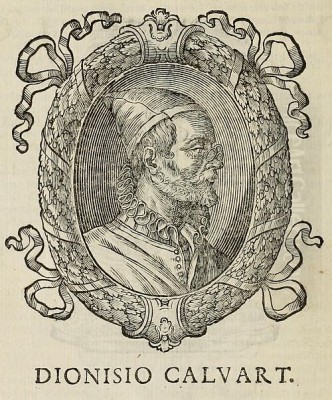
Denys Calvaert, known in Italy as Dionisio Fiammingo, stands as a fascinating figure in the transition from the late Renaissance to the early Baroque period. Born in Antwerp around 1540, he spent the majority of his highly productive artistic career in Italy, primarily in Bologna, where he died in 1619. Calvaert represents a significant bridge between the artistic traditions of Northern Europe, specifically Flanders, and the prevailing styles of Italy. His work and his influential teaching activities left an indelible mark on the Bolognese school of painting, nurturing a generation of artists who would rise to prominence in the 17th century. His Italian nickname, "Fiammingo," simply meaning "the Fleming," underscores his origins, yet his artistic identity became deeply intertwined with his adopted homeland.
Early Life and Formative Training
Denys Calvaert's artistic journey began in his native Antwerp, a bustling hub of commerce and art in the Spanish Netherlands. His initial training was reportedly under the landscape painter Christiaen van Queecborn (sometimes spelled Queecborne). This early exposure to landscape painting, a genre highly developed in the North, may have contributed to the detailed backgrounds often seen in his later works, even when the primary subject was religious or mythological. However, Calvaert's ambitions extended beyond the artistic scene of Antwerp.
Seeking to immerse himself in the heart of the Renaissance, Calvaert traveled to Italy. He arrived in Bologna, a city with a rich artistic heritage and part of the Papal States, which provided ample opportunities for patronage. Here, he entered the workshop of Prospero Fontana, a prominent local painter whose style reflected the Mannerist tendencies prevalent in Central Italy. Working with Fontana provided Calvaert with firsthand experience in figure drawing, composition, and the techniques favored by Italian masters.

His training continued under another significant Bolognese artist, Lorenzo Sabbatini. Calvaert became a valued assistant to Sabbatini, absorbing his refined Mannerist style, characterized by elegant figures, complex poses, and sophisticated compositions. This apprenticeship proved crucial, not only for honing his technical skills but also for integrating him into the Italian artistic network. The influence of both Fontana and Sabbatini is discernible in Calvaert's developing style, which began to merge Flemish precision with Italian grace.
Roman Interlude and Artistic Maturation
A pivotal moment in Calvaert's career occurred around 1572 when he accompanied Lorenzo Sabbatini to Rome. Sabbatini had been commissioned to work on the decorations of the Sala Regia in the Vatican Palace, a prestigious project overseen during the papacy of Gregory XIII. Assisting Sabbatini in this grand environment exposed Calvaert directly to the monumental works of the High Renaissance masters, particularly Raphael and Michelangelo.
The experience in Rome was transformative. Calvaert dedicated himself to studying the masterpieces he encountered, reportedly spending considerable time drawing from Raphael's frescoes and Michelangelo's powerful figures in the Sistine Chapel. This immersion in the Roman school tempered the more elaborate aspects of Mannerism he had learned in Bologna, instilling in him a greater appreciation for classical structure, anatomical accuracy, and compositional clarity. He also studied ancient Roman sculpture, further refining his understanding of the human form. This period solidified his technical foundation and broadened his artistic vocabulary, allowing him to synthesize various influences into a more personal style upon his return to Bologna.
The Bolognese Workshop: A Crucible of Talent
After his Roman sojourn and the death of Lorenzo Sabbatini in 1576, Denys Calvaert returned to Bologna and established his own independent workshop and academy. This studio quickly gained renown and attracted a large number of students, becoming one of the most important centers of artistic training in Bologna before the rise of the Carracci Academy. Calvaert was known as a dedicated, if reportedly strict, teacher, emphasizing rigorous drawing practice, the study of anatomy, perspective, and architecture.
His teaching methods, combining Flemish discipline with Italian artistic principles, proved highly effective. His academy produced some of the most celebrated painters of the next generation, who would dominate the Bolognese and Roman scenes in the early Baroque era. Among his most famous pupils were Guido Reni, Domenichino (Domenico Zampieri), and Francesco Albani. These artists, while eventually departing Calvaert's studio (some joining the rival Carracci Academy), carried forward the emphasis on draftsmanship, refined composition, and graceful figures instilled by their Flemish master.
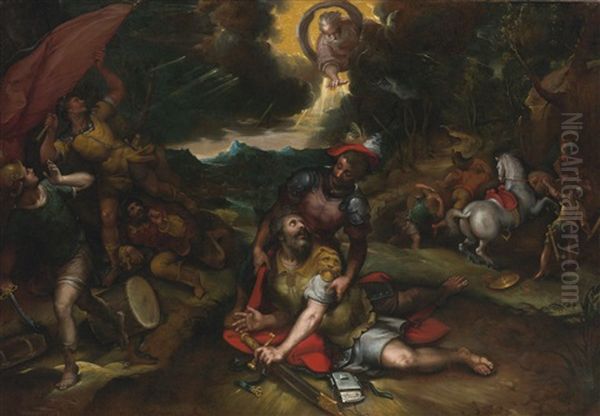
The success of Calvaert's academy highlights his significance not just as a painter but as a crucial educator who shaped the trajectory of Bolognese art. His influence extended even to his competitors; the structured approach of his school is sometimes seen as having provided a model or at least a point of comparison for Ludovico, Agostino, and Annibale Carracci when they established their own influential Accademia degli Incamminati around 1582. Calvaert's workshop remained active and respected for decades.
Artistic Style: A Synthesis of Traditions
Denys Calvaert's mature artistic style is characterized by a sophisticated fusion of his Northern heritage and his Italian training. He successfully integrated the meticulous attention to detail, rich color saturation, and emotional sensitivity often associated with Flemish painting with the idealized forms, elegant compositions, and classical principles of the Italian Renaissance and Mannerism. He consciously avoided what some contemporaries might have seen as the excessive, sometimes harsh, realism of certain Flemish artists, opting instead for a more refined and graceful aesthetic.
His works often feature clear, balanced compositions, frequently employing symmetrical arrangements and a strong sense of perspective, reflecting his studies of architecture and geometry. Figures are typically elegant and well-proportioned, rendered with anatomical accuracy but often imbued with a Mannerist grace in their poses and gestures. Calvaert was a masterful colorist, employing a rich and vibrant palette. His colors often have a luminous, enamel-like quality, and he skillfully used light and shadow (chiaroscuro) to model forms and create atmosphere, though generally avoiding the dramatic extremes later associated with Caravaggio.
His deep understanding of architecture is evident in the detailed settings of many paintings, while his knowledge of history and religious iconography informed his narrative clarity. Works like The Marriage at Cana exemplify his ability to handle complex multi-figure compositions with narrative coherence and visual appeal. His depictions of the Madonna and Child often combine tender intimacy with divine grace, showcasing his blend of Northern sentiment and Italian idealization.
Major Works and Thematic Focus
Throughout his long career, Denys Calvaert produced a substantial body of work, primarily focused on religious subjects, which were in high demand for churches and private devotion in Counter-Reformation Italy. He also occasionally tackled mythological themes. His paintings adorned numerous churches in Bologna and were sought after by collectors across Italy.
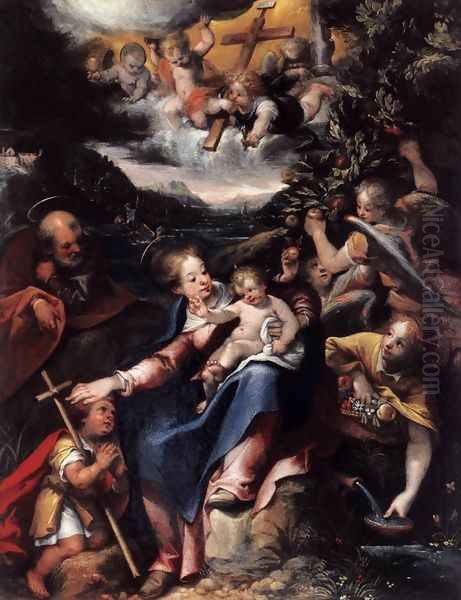
One of his most celebrated works is The Mystic Marriage of Saint Catherine. Several versions or related compositions exist, highlighting the popularity of the theme and Calvaert's skill in rendering the spiritual ecstasy and divine intimacy of the subject. The version often cited as a key work demonstrates his characteristic rich colors, elegant figures, and detailed execution. Sources suggest significant versions were located in Bologna and potentially later in a Paris private collection.
The Conversion of Saul (c. 1590), housed in the Basilica of San Giovanni in Monte, Bologna, is another powerful example of his narrative skill, capturing the dramatic moment of Saul's blinding vision on the road to Damascus. The dynamic composition and expressive figures showcase his ability to convey intense religious experience.
His Holy Family with the Infant St. John the Baptist in a Landscape, located in the Pinacoteca Nazionale di Bologna, reveals his Flemish roots in the detailed landscape background, combined with the sweet expressions and graceful interactions of the figures, typical of the Italian influence. Another work in the same museum, a preparatory study for an altarpiece depicting The Immaculate Conception, shows his working process and mastery of drawing.
Other notable religious works include The Triumph of St. Michael, created for the church of San Michele in Bosco, Bologna, depicting the archangel vanquishing the devil with characteristic energy and refinement. He painted numerous variations of the Madonna and Child with Saints, adapting the popular Sacra Conversazione format to his distinct style.
Interestingly, a work depicting Amor and Psyche, now attributed to Calvaert and held in the Metropolitan Museum of Art, New York, shows his engagement with mythological subjects derived from classical antiquity, treated with the same elegance and refined technique as his religious paintings. Technical analysis of this work has provided insights into his materials and methods.
An intriguing detail noted by art historians is the potential influence of Northern printmakers like Albrecht Dürer on some of Calvaert's iconographic choices, such as specific motifs in depictions of the infant Christ, demonstrating his continued connection to transalpine artistic currents even while fully integrated into the Italian scene.
Contemporaries and Connections
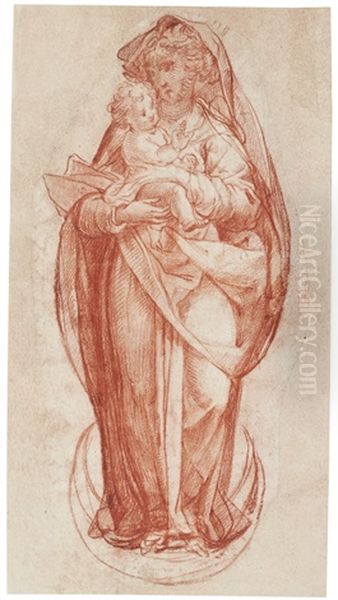
Denys Calvaert operated within a vibrant and competitive artistic milieu in Bologna and Rome. His primary teachers, Prospero Fontana and Lorenzo Sabbatini, were key figures in mid-16th century Bolognese Mannerism. His time in Rome brought him into the orbit of the legacy of High Renaissance giants Raphael and Michelangelo, whose works profoundly influenced him. He also would have been aware of the Venetian school's emphasis on color and light, perhaps through artists like Titian, Tintoretto, or Veronese, although his style remained more grounded in Central Italian traditions of drawing (disegno).
In Bologna, his main contemporaries and eventual rivals were the Carracci cousins: Ludovico, Agostino, and Annibale. While Calvaert represented a more traditional, albeit highly refined, late Mannerist approach fused with Flemish elements, the Carracci spearheaded a reform movement aimed at moving beyond Mannerist artifice towards a renewed naturalism, drawing inspiration from Correggio, Titian, and direct observation. The establishment of their Accademia degli Incamminati eventually eclipsed Calvaert's school in influence, attracting many talented students, including some who had started with Calvaert, like Reni and Albani.
Despite this rivalry, Calvaert remained a respected figure. His students, Guido Reni, Domenichino, and Francesco Albani, became leading proponents of the Bolognese school and the classical Baroque style in Rome, adapting Calvaert's emphasis on grace and clarity while incorporating the Carracci reforms and responding to new trends, including the dramatic naturalism of Caravaggio. Calvaert's legacy, therefore, is complex, existing both in his own works and in the foundational training he provided to artists who would define the subsequent era.
The occasional misattribution of his works, such as a Crucifixion once thought to be by Peter Paul Rubens or a Madonna and Child mistaken for Sabbatini's, speaks to the quality of his execution and the stylistic dialogues of the period. Rubens, another Flemish artist who found great success in Italy slightly later, represents a different path, embracing a more dynamic and robust Baroque style, but the comparison highlights the presence and impact of Northern artists in Italy. Calvaert's connection to Parmigianino might be seen through the shared Mannerist elongation and grace in figures, a style influential in Emilia-Romagna.
Challenges and Recognition: Attribution and Legacy
Like many artists of the past, Denys Calvaert faced challenges in terms of lasting recognition. While highly successful during his lifetime, with works commissioned for major churches and collected by cardinals and nobles, his fame was later somewhat overshadowed by his own students and the Carracci. For a period, his contributions were relatively underestimated in broader art historical narratives.
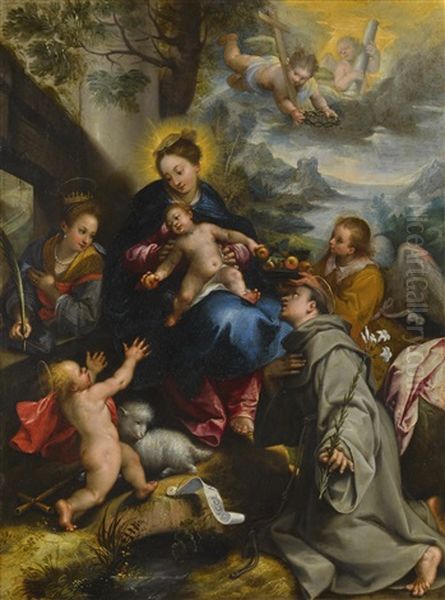
Furthermore, issues of attribution have occasionally clouded the assessment of his oeuvre. As mentioned, works have been misattributed to both his teacher Sabbatini and the later Flemish master Rubens. Correctly identifying and cataloging his works has been an ongoing task for art historians, aided by stylistic analysis and documentary research. Technical studies, such as those performed on the Amor and Psyche, also contribute to a better understanding of his practice and help confirm attributions.
In recent decades, however, there has been a renewed appreciation for Calvaert's art. Scholars have increasingly recognized his pivotal role in Bolognese painting and his unique synthesis of Northern and Italian traditions. His works appear more frequently in exhibitions and at auction, often commanding significant attention. His paintings are preserved in important collections, notably in Bologna (Pinacoteca Nazionale, various churches like San Petronio Basilica, San Giovanni in Monte, San Michele in Bosco), but also in Florence, Rome, St. Petersburg, Parma, Caen, and other international museums.
This rediscovery highlights his technical brilliance, the appealing grace of his style, and his historical importance as a bridge figure and influential teacher. His legacy is not merely in the paintings bearing his name but also in the artistic lineage that passed through his studio.
Enduring Influence and Historical Significance
Denys Calvaert occupies a significant place in late 16th and early 17th-century art history. He was a key figure in the Bolognese school during the period immediately preceding the dominance of the Carracci reform. His ability to master and synthesize Italian Renaissance and Mannerist principles while retaining elements of his Flemish heritage resulted in a distinctive and highly refined style that appealed greatly to patrons of the Counter-Reformation era.
His most enduring influence arguably lies in his role as an educator. The rigorous training provided in his academy laid the groundwork for the careers of Reni, Domenichino, and Albani, artists who became central figures of Italian Baroque classicism. Through them, Calvaert's emphasis on careful drawing, elegant composition, and refined execution was transmitted and transformed, contributing significantly to the artistic language of the 17th century.
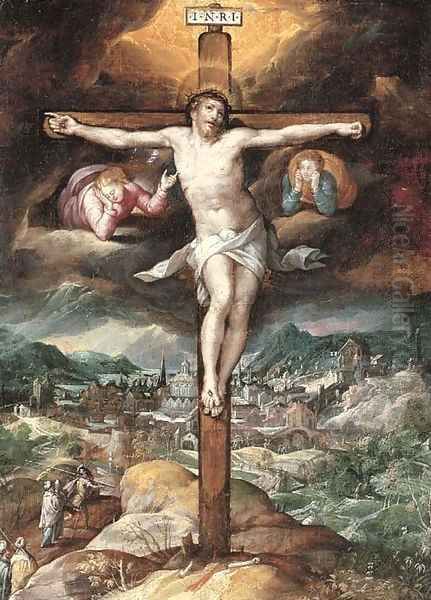
Historically, Calvaert exemplifies the fruitful interaction between Northern European and Italian art during the Renaissance and Baroque periods. He was one of many artists from the Low Countries who sought training and fortune in Italy, but he stands out for his long-term success, his integration into the local art scene, and his profound impact as a teacher in a major Italian artistic center. He represents an important strand of late Mannerism infused with a particular Northern sensibility, offering a sophisticated alternative to the emerging Baroque styles.
Conclusion
Denys Calvaert, or Dionisio Fiammingo, was more than just a Flemish painter working in Italy. He was a master synthesizer of artistic traditions, a creator of elegant and emotionally resonant religious and mythological works, and a profoundly influential teacher. His long career in Bologna cemented his position as a cornerstone of the city's artistic life in the late 16th century. While perhaps less universally known today than his most famous pupils or his Carracci rivals, Calvaert's artistic achievements and his role in shaping the next generation of Baroque masters secure his importance in the narrative of European art history. His works continue to be admired for their technical finesse, luminous color, and graceful beauty, reflecting a unique blend of Northern precision and Italian elegance.